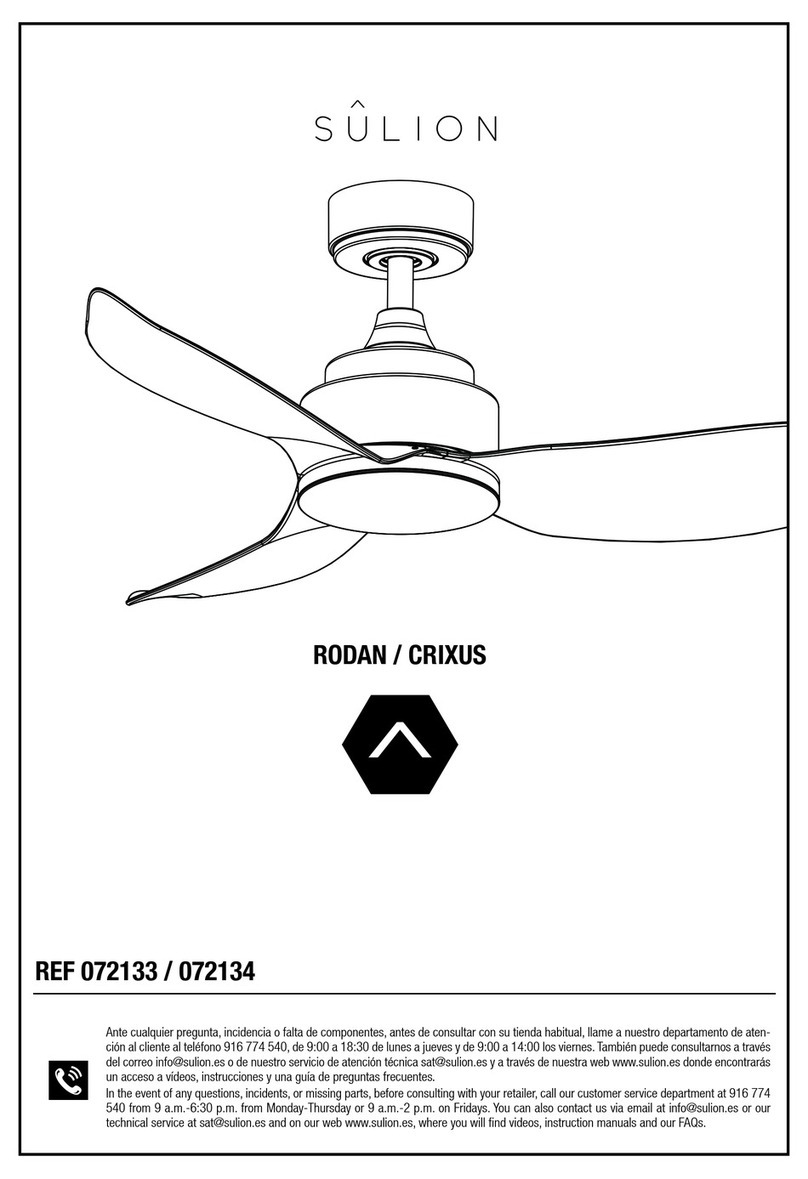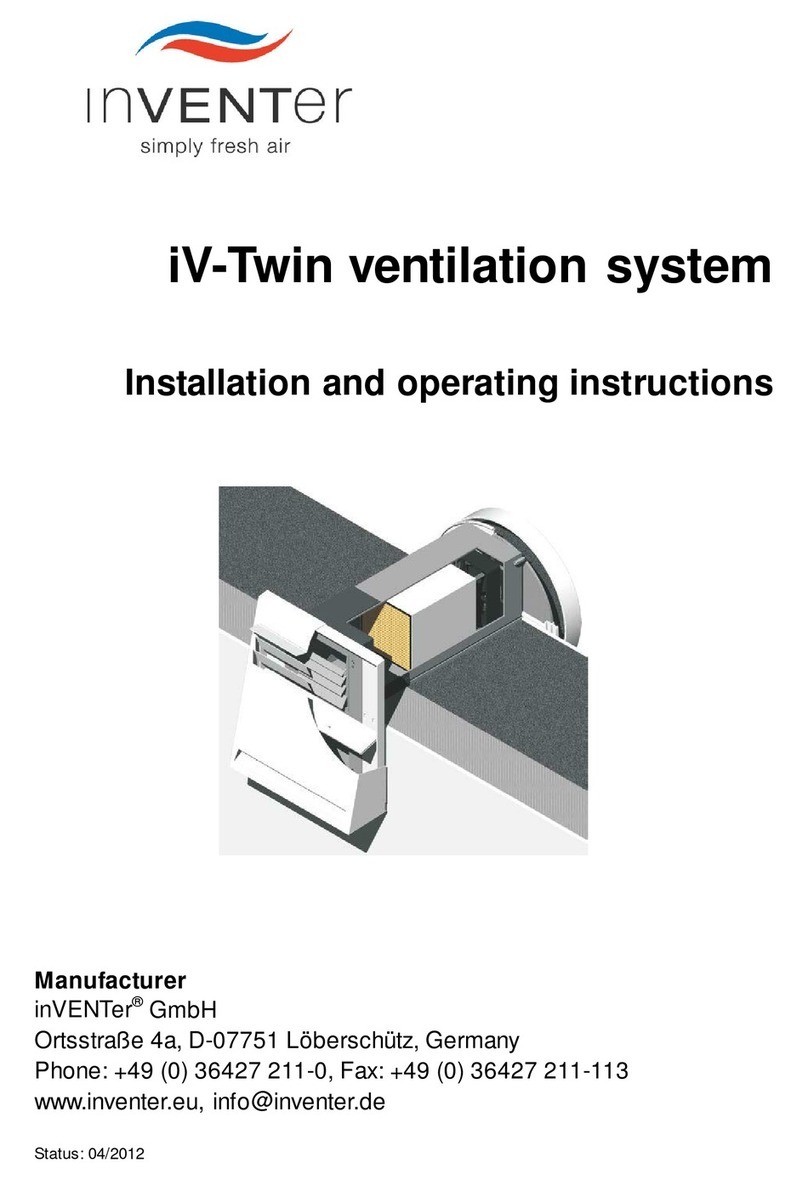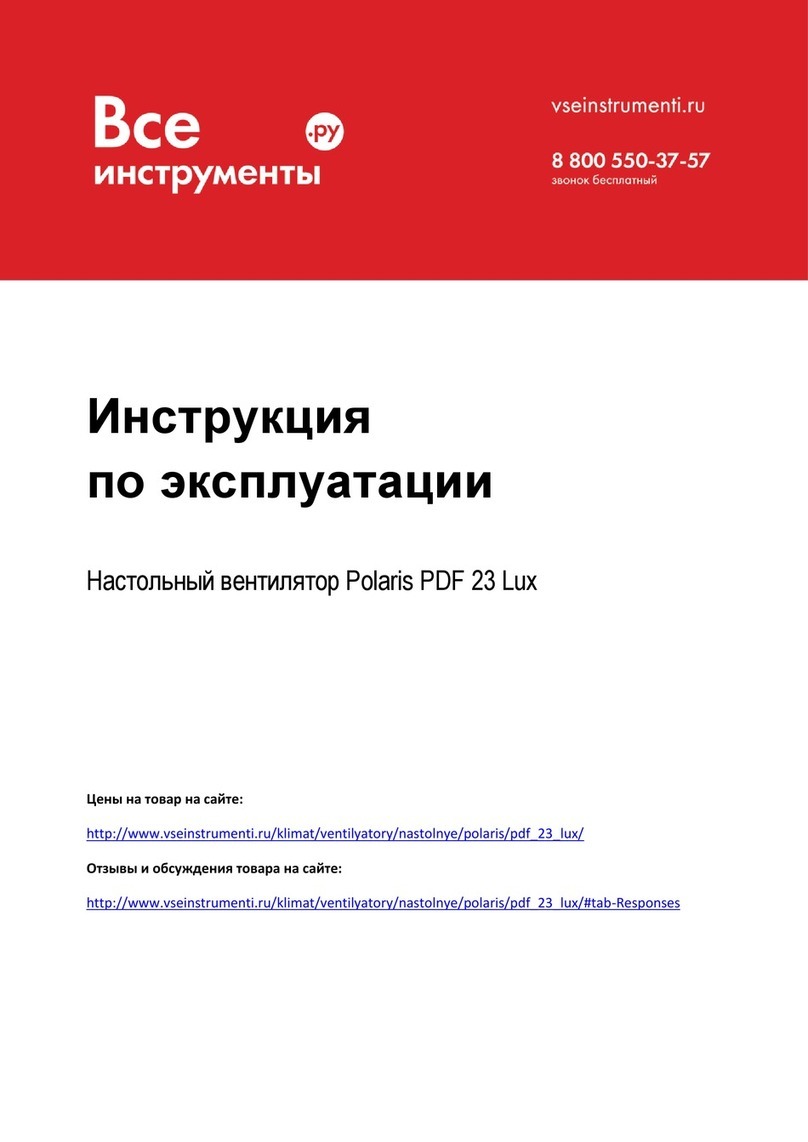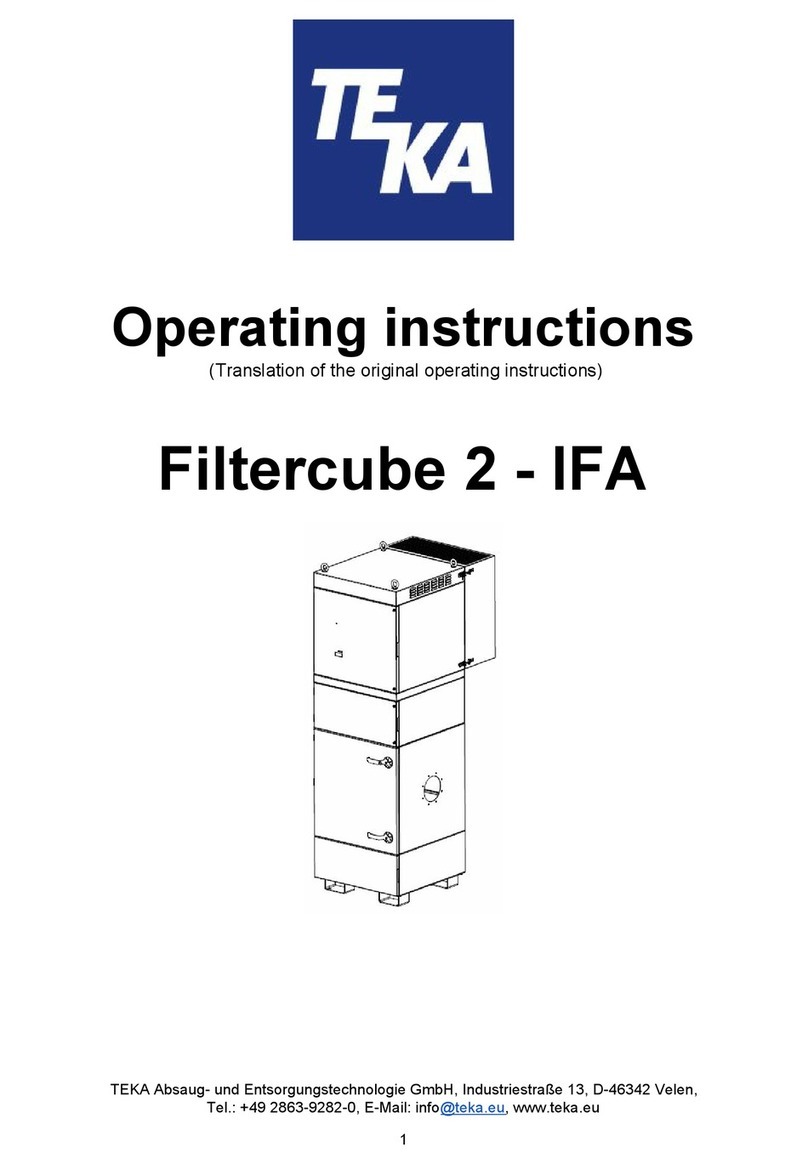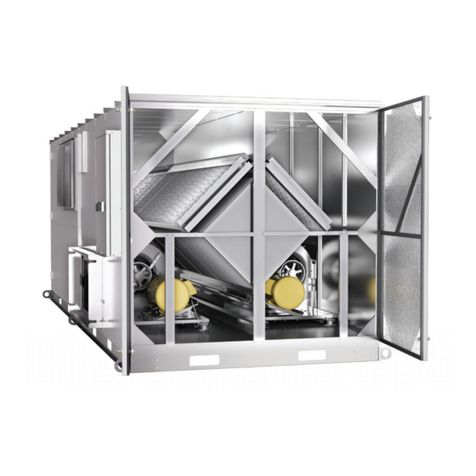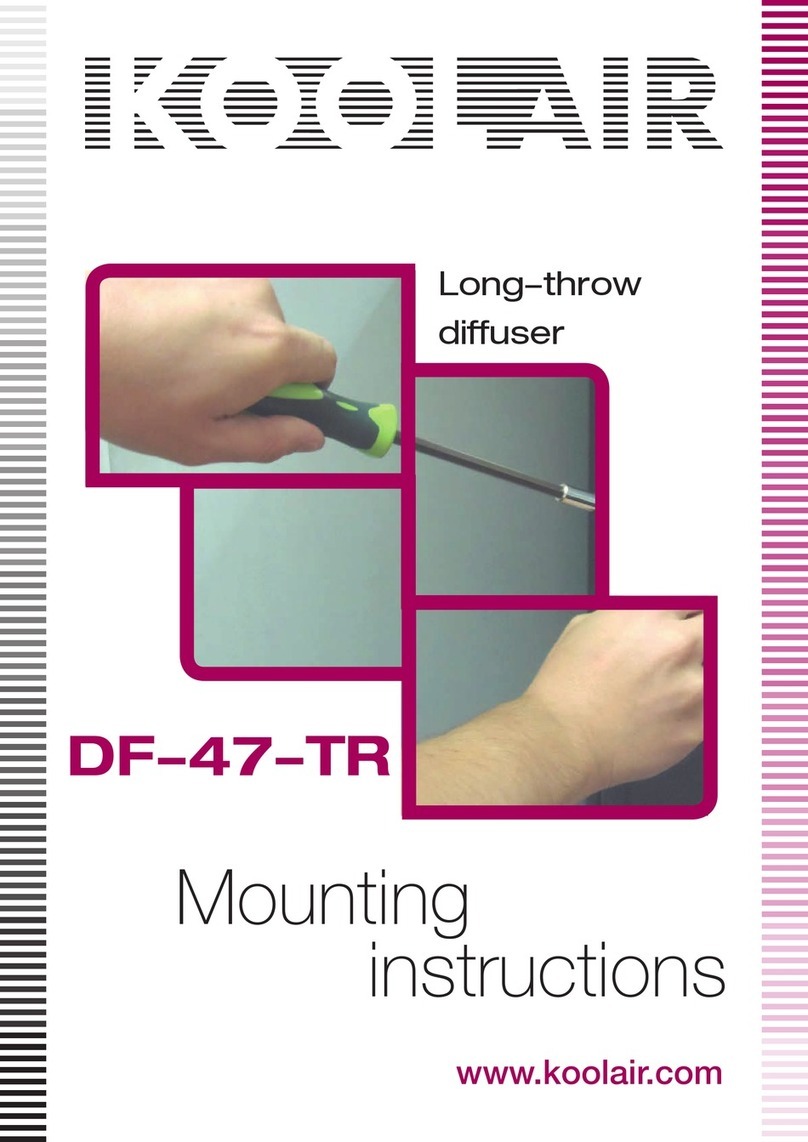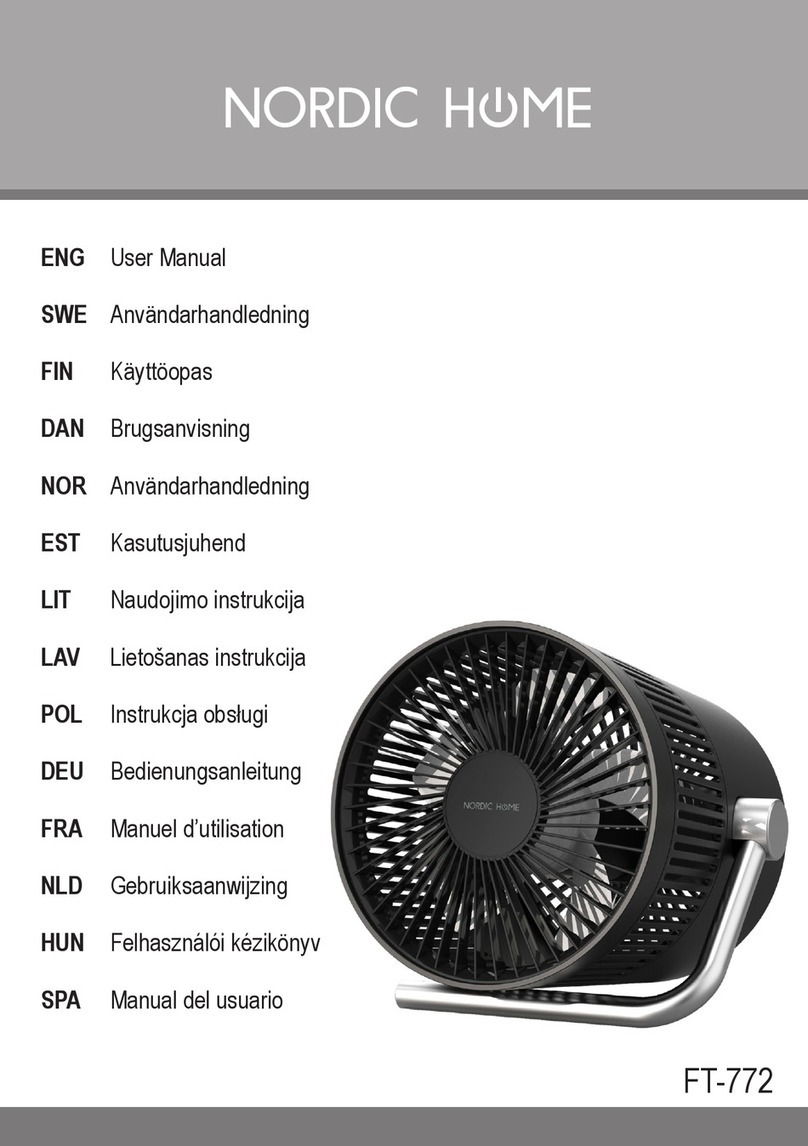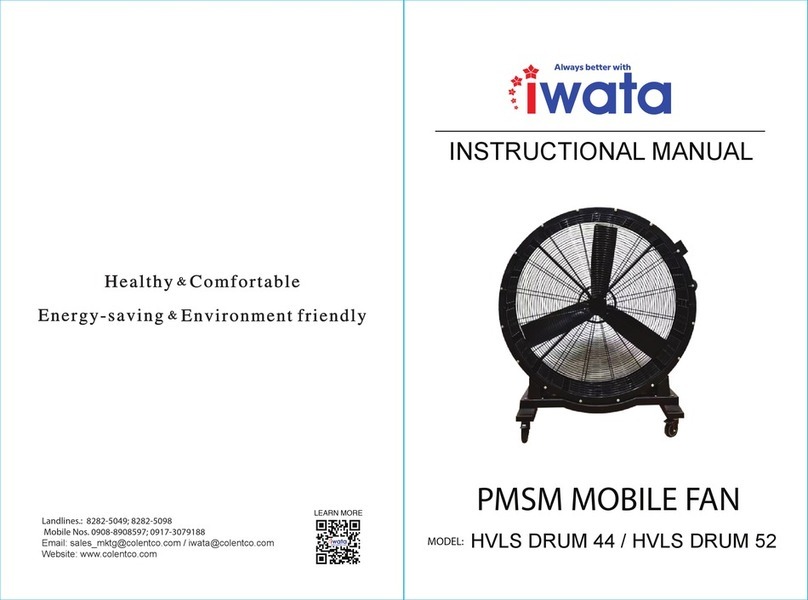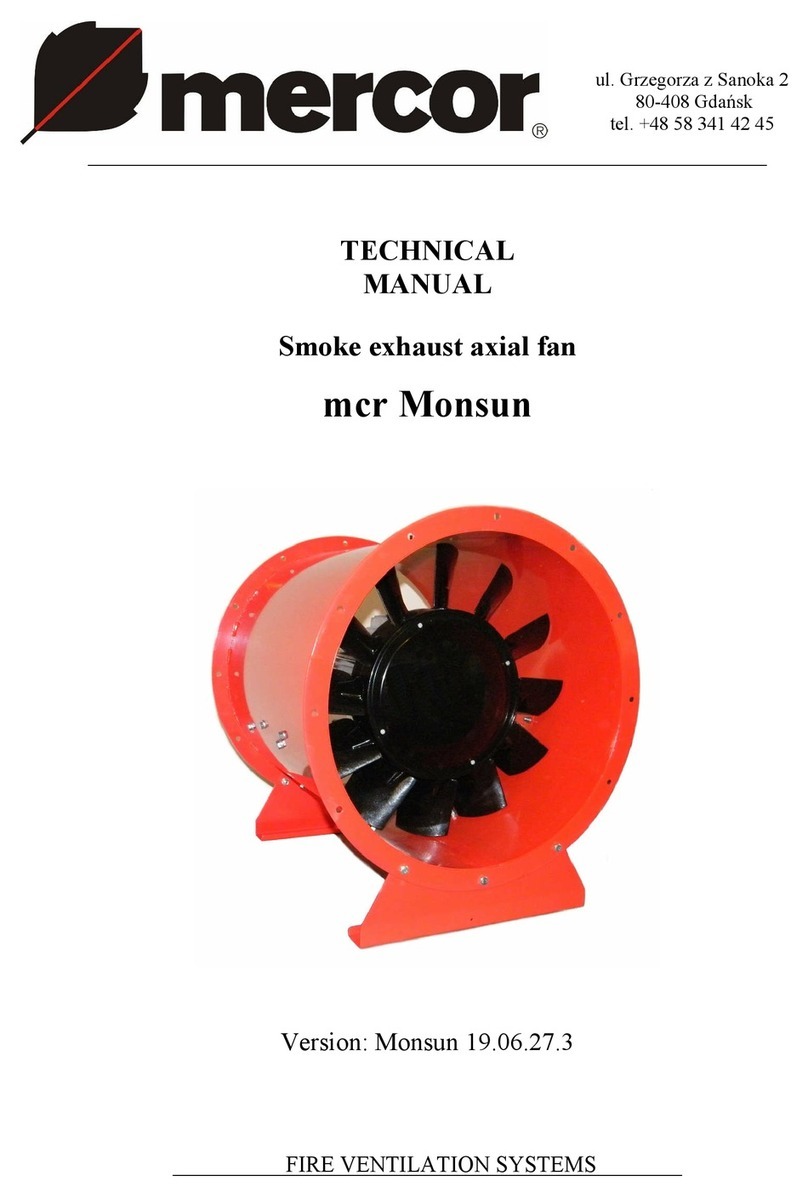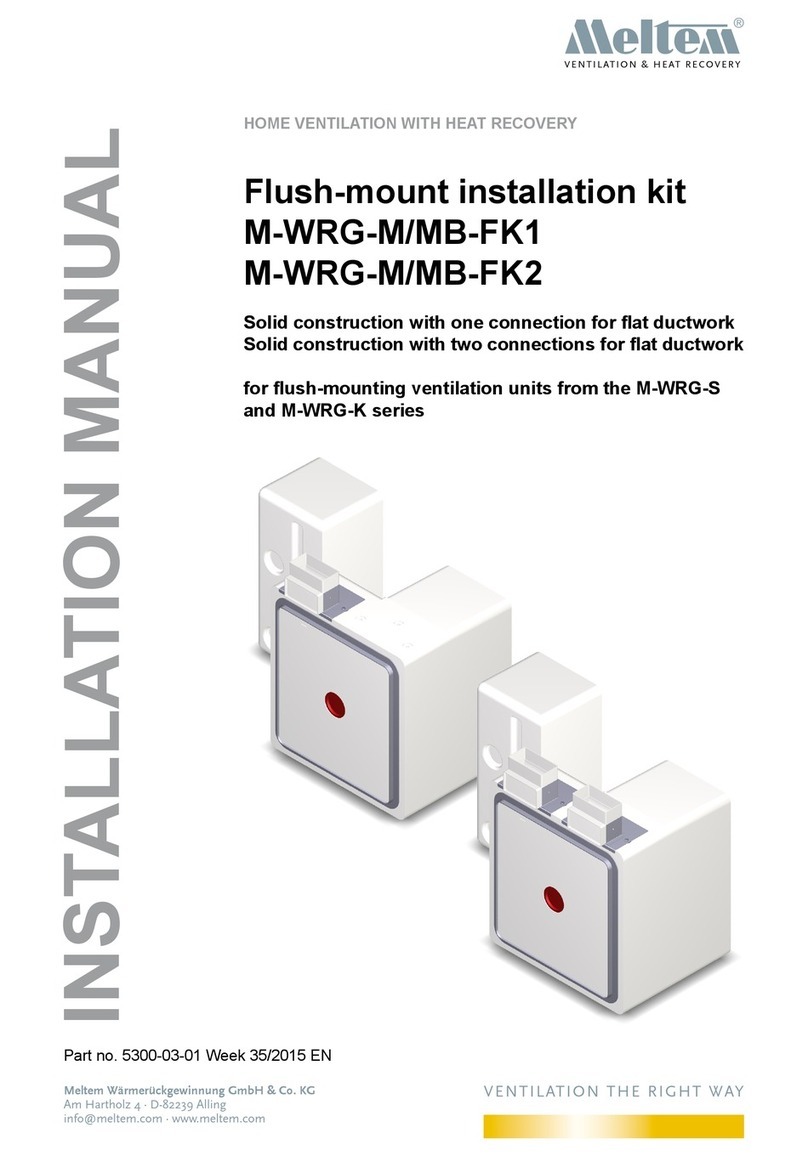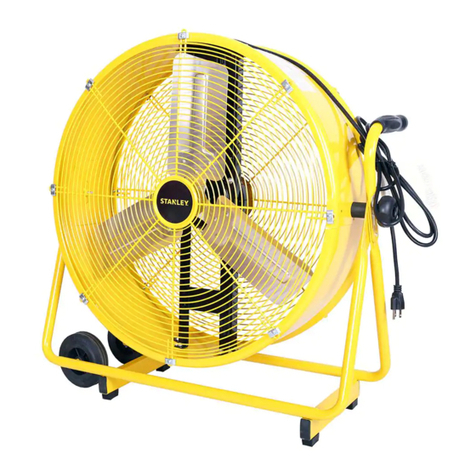Envirowise QF130V User manual

IMPORTANT INSTRUCTIONS -
OPERATING MANUAL
SAVE THESE INSTRUCTIONS
6727931 Rev. C 10-17 1 of 8
Supply Inline Fan
QF130V
READ AND SAVE THESE INSTRUCTIONS
READ CAREFULLY BEFORE ATTEMPTING TO ASSEMBLE, INSTALL, OPERATE OR MAINTAIN
THE PRODUCT DESCRIBED. PROTECT YOURSELF AND OTHERS BY OBSERVING ALL SAFETY
INFORMATION. FAILURE TO COMPLY WITH INSTRUCTIONS COULD RESULT IN PERSONAL
INJURY AND/OR PROPERTY DAMAGE!
RETAIN INSTRUCTIONS FOR FUTURE REFERENCE.
GENERAL SAFETY INFORMATION
When using electrical appliances, basic precautions should
always be followed to reduce the risk of fire, electric shock and
injury to person, including the following:
WARNING:TO REDUCE THE RISK
OF FIRE, ELECTRIC SHOCK AND INJURY TO
PERSON, OBSERVE THE FOLLOWING:
a) Use this unit only in the manner intended by the manufacturer. If you
have questions, contact the manufacturer.
b) Before servicing or cleaning the unit, switch power off at service
panel and lock the service disconnecting means to prevent
power from being switched on accidentally. When the service
disconnecting means cannot be locked, securely fasten a
prominent warning device, such as a tag, to the service panel.
WARNING:TO REDUCE THE RISK
OF FIRE, ELECTRIC SHOCK AND INJURY TO
PERSON, OBSERVE THE FOLLOWING:
a) Installation work and electrical wiring must be done by qualified
person(s) in accordance with all applicable codes and standards,
including fire-related construction.
b) Sufficient air is needed for proper combustion and exhausting
of gases through the flue (chimney) of fuel burning equipment
to prevent back drafting. Follow the heating equipment
manufacturer’s guideline and safety standards such as those
published by the National Fire Protection Association (NFPA)
and the American Society for Heating, Refrigeration, and Air
Conditioning Engineers (ASHRAE), and the local code authorities.
c) When cutting or drilling into wall or ceiling, do not damage electrical
wiring and other hidden utilities.
CAUTION:FOR GENERAL VENTILATING USE
ONLY. DO NOT USE TO EXHAUST HAZARDOUS OR
EXPLOSIVE MATERIALS AND VAPORS.
d) This unit must be grounded.
e) To avoid motor bearing damage and noisy and/or unbalanced impellers,
keep drywall spray, construction dust, etc. off power unit.
f) Read all instructions before installing or using exhaust fan.
g) For residential installations only.
h) Must use suitable weather hood with insect screen to protect air
intake.
WARNING:TO REDUCE THE RISK OF
FIRE, ELECTRIC SHOCK, DO NOT USE THIS FAN
WITH ANY SOLID-STATE SPEED CONTROL
DEVICE.
a) Must be connected to a GFCI (ground fault circuit interrupter)
protected branch circuit.
WARNING:DO NOT USE IN KITCHENS.
WARNING: THE DUCTING FROM THIS FAN HAS A
STRONG EFFECT ON THE AIR FLOW, NOISE AND ENERGY
USE OF THE FAN. USE THE SHORTEST, STRAIGHTEST DUCT ROUTING
POSSIBLE FOR BEST PERFORMANCE, AND AVOID INSTALLING THE FAN
WITH SMALLER DUCTS THAN RECOMMENDED. INSULATION AROUND
THE DUCTS CAN REDUCE ENERGY LOSS AND INHIBIT MOLD GROWTH.
Installing Contractor:
Installation Date:
Model Number: QF130V
18-HE118D1-1-EN

INSTALLATION INSTRUCTIONS
CAUTION: MAKE SURE POWER IS SWITCHED OFF AT
SERVICE PANEL BEFORE STARTING INSTALLATION.
SECTION 1
Preparing the Fan
1. Unpack fan from the carton and confirm
that all pieces are present. In addition to
the fan you should have:
2 - Collar Assembly (attached)
2 - Mounting Brackets (attached)
1 - Controller (attached)
1 - 24 volt relay box (Included with
unit shipped loose in box)
1 - Instruction/Safety Sheet
2. Choose the location for your fan. To ensure
the best air and sound performance, it is
recommended that the length of ducting
and the number of elbows be kept to a
minimum, the radius of each elbow be as
large as possible for the installation, and
that insulated hard ducting be used. This
fan will require at least 12" of clearance in
the ceiling or wall. The fan mounts using
the provided mounting brackets or can be
surface mounted to a wall or ceiling.
NOTE: The fan must be installed into a location
that can be easily accessed once installed.
3. There are typically three installation options
for the unit:
Intake to Central Grill: The unit is
mounted into the attic space and the
airflow is directed through ducting to a
central location of the home (Figure 1).
Intake into HVAC System: The unit is
mounted next to the HVAC system with the
airflow directed into the return of the HVAC
system (Figure 2).
Direct Intake: The unit is mounted in a
mechanical room, laundry room or other
less occupied area and the airflow comes
directly into the space without the need
for extra ducting or tying into the HVAC
(Figure 3).
4. No additional vibration deadening materials
are needed for this fan.
SECTION 2
Mounting the Fan
1. Confirm the fan is positioned so the air
flow is in the correct direction.
2a. Surface Mounting: Locate at least one
stud or joist. Place the fan in position so
that the mounting bracket is centered on the stud or joist and make the location for the
four (4) holes. Remove the fan and install properly rated wall/ceiling anchors for the
holes that do not go directly into a joist or stud. Position fan in place and secure with
screws (not included) (Figure 4).
6727931 Rev. C 10-17 2 of 8
2b. Mounting to a Joist: Install two - 2 x 4 headers (not included) between the joists.
Position the fan housing on top of the headers and secure the mounting brackets with
screws (not included) to the header (Figure 5).
2c. Hanging Bar Mounting: Lift unit up onto the threaded rods and secure in place using
appropriate hardware (not included) (Figure 6).
SECTION 3
Ducting
NOTE: 6" OR LARGER RIGID DUCT OR 8" FLEX DUCTING IS RECOMMENDED FOR BEST
PERFORMANCE. DO NOT RUN MORE THAN 100 FEET OF TOTAL DUCTING (INCLUDES
SUPPLY AND RETURN). 8" FLEX DUCT @ 130CFM HAS ESP OF .06 FOR 100 LINEAR FEET
OF TOTAL DUCT. PRESSURE DROP FOR FILTER, INTAKE HOOD AND OUTLET GRILL MUST
BE ADDED TO GET TO TOTAL SYSTEM PRESSURE DROP.
CAUTION: ALL DUCTING MUST COMPLY WITH LOCAL AND
NATIONAL BUILDING CODES.
NOTE: The ducting from this fan to the outside of the building has a strong effect on the air
flow, noise and energy use of the fan. Use the shortest, straightest duct routing possible
for best performance, and avoid installing the fan with smaller ducts than recommended.
Insulation around the ducts is required if QF130V is installed in non-conditioned space and is
recommended for all installations to reduce energy loss and inhibit mold growth.
WARNING: MAKE SURE THE FRESH AIR INTAKE PORT COMPLIES
WITH ALL LOCAL AND NATIONAL CODES AND IS LOCATED AT LEAST 6 FEET
AWAY FROM SOURCES OF CONTAMINATION SUCH AS BUT NOT LIMITED TO: DRYER,
FURNACE OR CENTRAL VACUUM EXHAUSTS, GAS APPLIANCES SUCH AS BBQ GRILLS,
GARBAGE BINS OR OTHER EXHAUST PORTS.
NOTE: To ensure quiet operation of in-line and remote fans, each fan shall be installed
using sound attenuation techniques appropriate for the installation. For general ventilation
applications, at least 8 feet of insulated flexible duct shall be installed between the exhaust or
supply grille(s) and the fan.
1. Connect the ducting to the fan’s duct collar (Figure 7). Seal ducting to housing with
appropriately rated tape. Use screws or suitable clamps to secure in place. Make sure
the fresh air intake is connected to a properly installed intake port that is a suitable
weather hood with insect screen to protect air intake. It is recommended that low
restriction termination fittings be used.
2. Ensure duct joints and exterior penetrations are sealed with caulk or other similar material
to create an air-tight path to minimize building heat loss or gain and to reduce the potential
for condensation. Place/wrap insulation around duct and/or fan in order to minimize
possible condensation buildup within the duct, as well as building heat loss or gain.
Bracket
Figure 6
Housing
Threaded Rod
Figure 4
Screws
Stud/Joist Anchor
Air Flow
Joist
2 x 4 Header
Figure 5
Bracket
12"
Figure 7
Air Flow
Intake
Ducting
Outlet
Ducting
Test Port
Figure 1
Unit
Intake to Central Grill
Grill
Wall Cap
Intake into HVAC System
HVAC
Return
Intake from
Wall Cap
Unit
NOTE: Blower interlock
is recommended in this
application but is not required.
Figure 2
Direct Intake
Intake from
Wall Cap
Figure 3
Unit

NOTE: At the base of the duct adapter, there is a small diameter test port hole covered with
a plastic cap. Make sure the test port is not covered up with the ducting so that it can be
accessed for pitot tube testing. To access the port, remove the port cover and insert tube.
SECTION 4
Wiring
CAUTION: MAKE SURE POWER IS SWITCHED OFF AT SERVICE PANEL BEFORE
STARTING INSTALLATION.
CAUTION: ALL ELECTRICAL CONNECTIONS MUST BE
MADE IN ACCORDANCE WITH LOCAL CODES, ORDINANCES, OR
NATIONAL ELECTRICAL CODE. IF YOU ARE UNFAMILIAR WITH
METHODS OF INSTALLING ELECTRICAL WIRING, SECURE THE
SERVICES OF A QUALIFIED ELECTRICIAN.
NOTE: This unit includes a side access panel for wiring that does not require the removal of the
fan’s blower assembly.
1. Remove the wire compartment cover screw and place cover in a secure place (Figure 8).
2. Pull the loose black, white and green wires out from the wire compartment (additional
wires will be present). Install an approved electrical connector to the wire compartment
cover (not included). Run a black (hot), white (neutral), and a green or bare ground
wire from the supply through the electrical connector. Connect all wires from the supply
to their corresponding wires within the wire compartment (Figure 9). Use approved
methods for all connections.
3. Carefully tuck wires back inside
wire compartment and replace wire
compartment cover securing with the
screw that was removed earlier.
SECTION 5
Setting the Speed
1. Remove the screw securing the access
panel cover in place and open the cover
to gain access (Figure 10).
2. Locate the speed control panel inside the
unit (Figure 11).
3. Set the dial to the required CFM as
determined by Table 4.1a. The unit can be
set from 30 CFM to 130 CFM (Figure 11).
6727931 Rev. C 10-17 3 of 8
SECTION 6
24V Control Relay
The 24V relay controller allows the until to be controlled from a remote located thermostat
with ventilation logic software or a switch. It is not necessary to install the 24V relay if the
QF130V is controlled by the unit mounted programmable controller.
NOTE: The 24V relay works in conjunction with the unit mounted programmable controller installed
on the QF130V and wall mounted thermostats that contain ventilation logic software. For the unit
to operate, it must be energized at the controller location connected by the 24V relay and meet the
preset criteria programmed into the unit mounted programmable controller. The Internal/External
switch must be in the External position or the remote controller will be bypassed.
CAUTION: MAKE SURE POWER IS SWITCHED OFF AT
SERVICE PANEL BEFORE STARTING INSTALLATION.
CAUTION: ALL ELECTRICAL CONNECTIONS MUST BE
MADE IN ACCORDANCE WITH LOCAL CODES, ORDINANCES, OR
NATIONAL ELECTRICAL CODE. IF YOU ARE UNFAMILIAR WITH METHODS OF INSTALLING
ELECTRICAL WIRING, SECURE THE SERVICES OF A QUALIFIED ELECTRICIAN.
1. Run approved low voltage wiring from the remote located controller/switch to the
relay box through the grommet on the side panel of the unit. Connect the wires to the
bare blue leads inside the relay box. Secure the low voltage wire to the relay controller
box using the cable tie provided. Thread the cable tie through opening in the Cable Tie
Holder. Wrap the wire around the cable tie twice and tighten the cable tie.
2. Remove the installed Molex jumper harness from the connector on the top of the wiring
compartment.
3. Install the relay control box by sliding the unit into the corner of the housing, remove
the jumper wire and connect the Molex on the box to the connector in the housing. This
will only fit one way. Secure the box to the housing using the included screws (Figure
12).
Operation
1. When the toggle switch is in the “Internal”
position, the unit will bypass the relay and
operate the unit as controlled by the unit
mounted programmable controller.
NOTE: Important to double check the toggle position
before completing the installation!
2. When the toggle switch is in the “External”
position the unit will only energize when
the remote located controller is energized,
a ventilation call is activated by the remote
controller, and all the criteria (humidity,
temperature, etc.) of the unit mounted
programmable controller are met.
Figure 8
Screw
Wire
Compartment
Cover
Ground
Screw
Figure 9
Supply from house
Black
Neutral (White)
Ground (Green or Bare)
Fan
Neutral (White)
Green
Black
Green
Figure 12
Relay Box
Molex
Connector
Screws
Screw
Figure 10
Screw
3
0
4
0
5
0
6
0
7
0
8
0
9
0
1
0
0
1
1
0
1
2
0
1
3
0
Speed
Control
3
0
4
0
5
0
6
0
7
0
8
0
9
0
1
0
0
1
1
0
1
2
0
1
3
0
Figure 11
External
Internal
Figure 13
Relay
Box
Toggle Switch
Table 4.1a (I-P) Ventilation Air Requirements, cfm
Floor Area, ft2
Bedrooms
12345
<500 30 38 45 53 60
501 - 1000 45 53 60 68 75
1001 - 1500 60 68 75 83 90
1501 - 2000 75 83 90 98 105
2001 - 2500 90 98 105 113 120
2501 - 3000 105 113 120 128
3001 - 3500 120 128
Note: When calculating MVR, Minimum Ventilation Rate, State/Local Personnel should always
be consulted for Best Practices based on 62.2. There should not be greater than 7.5cfm/100ft².

6727931 Rev. C 10-17 4 of 8
SECTION 7
Connected Control Wiring
Onboard controller information to the unit.
SECTION 8
Motorized Damper
An optional motorized damper can be connected
to the unit. The damper is connected via a 24V
transformer that plugs into the receptacle in the
unit (Figure 14).
NOTE: Make sure to reference the instructions
included with the motorized damper before
installing or operating.
Operation
1. When installed the receptacle will be
energized anytime the fan is running. This
will in turn open the damper. When the fan
stops running, the damper will close.
SECTION 9
Air Filter
An air filter (included separately) can be added to this unit to provide additional filtration of the
intake air. The unit will accept a nominal 10” x 10” x 2” filter. To install:
NOTE: Filters must be changed regularly. Refer to the filter manufacturer’s recommendations
to determine how often the filter should be changed.
1. Remove the screw securing the access panel cover in place and open the cover to gain
access to the controls and filter area.
2. Ensure the filter is facing the correct way and slide the filter into the slot in the housing.
Make sure the filter is seated all the way to the bottom of the housing (Figure 15).
3. Close the access panel and reinstall the screw holding the access panel in place.
SECTION 10
Completing the Installation
NOTE: Double check the toggle switch position to ensure correct operation according to control
application.
NOTE: When fan is mounted inline and no penetration is made into unconditioned spaces, there
is no need to use a sealant appropriate for contact with the building materials present and for the
temperature requirements of the installation to prevent air leakage from unconditioned spaces.
Additional material (backing rod, ceiling material) are also not required.
1. Close the access panel and reinstall the screw holding the access panel in place.
2. Restore power and test your installation.
SECTION 11
Setting the QF Controller
The unit mounted programmable controller monitors temperature and humidity of incoming
air and allows the installer to configure optimal ventilation.
With power to the unit turned on, the initial screen will show “OFF”. Press the “ON” button to
show the current temperature and humidity condition. By pressing the “ON” button, the unit
will turn on for continuous air flow using the CFM settings from SECTION 5 Setting the Speed.
ON / OFF /
ENERGY SAVING
CONFIGURE UP DOWN
Figure 15
Filter
Screw
Air Flow
3
0
4
0
5
0
6
0
7
0
8
0
9
0
1
0
0
1
1
0
1
2
0
1
3
0
Figure 14
Receptacle
3
0
4
0
5
0
6
0
7
0
8
0
9
0
1
0
0
1
1
0
1
2
0
1
3
0
SOV
STG2
STG1
STG1
STG3
STG2
FAN
PWM
HUM
HUM
AUX1
AUX1
AUX2
AUX2
24V
ONLY
24V
ONLY
24V
ONLY
O
Y1
Y2
W1
W2
W3
G
BK
HUM*
HUM*
AUX1*
AUX1*
AUX2*
AUX2*
RELAY PANEL ENVIROWISE Q130V
TCONT850/1050
COMMUNICATING
CONTROL
DRB
D
R
B
AUX 1
AUX 2
24VAC HOT
COMMON
SOV
COOLING
FAN
HEATING
ODT
RS
AUX1
AUX1
AUX2
AUX2
RC
RH
B/C
O
Y1
Y2
G
BK
W1
W2
W3
ODT
ODT
RS1
RS1
824 COMFORT CONTROL
External
Internal
X
RELAY BOX
BLUE
BLUE
ENVIROWISE Q130V
External
Internal
X
RELAY BOX
BLUE
BLUE
NOTES:
1) Use #18 gauge solid or stranded wire.
2) Connect the wire between “R” and “AUX1” in the relay panel.
3) Connect the wire from the other remaining “AUX1” to the blue lead
of the ventilator relay box.
4) Connect the wire from “B” of the relay panel to the other blue
lead of the ventilator relay box.
5) See the TCONT850/1050 Installation Guide for instructions on
setting up the “AUX1” contacts for ventilation operation.
NOTES:
1) Use #18 gauge solid or stranded wire.
2) Connect the wire between “AUX1” and “RC” in the 824 Control.
3) Connect the wire from the other remaining “AUX1” to the blue lead
of the ventilator relay box.
4) Connect the wire from “B/C” of the 824 Controller to the other blue
lead of the ventilator relay box.
5) See the TCONT824 Installation Guide for instructions on
setting up the “AUX1” contacts for ventilation operation.
SOV
STG2
STG1
STG1
STG3
STG2
FAN
PWM
HUM
HUM
AUX1
AUX1
AUX2
AUX2
24V
ONLY
24V
ONLY
24V
ONLY
O
Y1
Y2
W1
W2
W3
G
BK
HUM*
HUM*
AUX1*
AUX1*
AUX2*
AUX2*
RELAY PANEL ENVIROWISE Q130V
TCONT850/1050
COMMUNICATING
CONTROL
DRB
D
R
B
AUX 1
AUX 2
24VAC HOT
COMMON
SOV
COOLING
FAN
HEATING
ODT
RS
AUX1
AUX1
AUX2
AUX2
RC
RH
B/C
O
Y1
Y2
G
BK
W1
W2
W3
ODT
ODT
RS1
RS1
824 COMFORT CONTROL
External
Internal
X
RELAY BOX
BLUE
BLUE
ENVIROWISE Q130V
External
Internal
X
RELAY BOX
BLUE
BLUE
NOTES:
1) Use #18 gauge solid or stranded wire.
2) Connect the wire between “R” and “AUX1” in the relay panel.
3) Connect the wire from the other remaining “AUX1” to the blue lead
of the ventilator relay box.
4) Connect the wire from “B” of the relay panel to the other blue
lead of the ventilator relay box.
5) See the TCONT850/1050 Installation Guide for instructions on
setting up the “AUX1” contacts for ventilation operation.
NOTES:
1) Use #18 gauge solid or stranded wire.
2) Connect the wire between “AUX1” and “RC” in the 824 Control.
3) Connect the wire from the other remaining “AUX1” to the blue lead
of the ventilator relay box.
4) Connect the wire from “B/C” of the 824 Controller to the other blue
lead of the ventilator relay box.
5) See the TCONT824 Installation Guide for instructions on
setting up the “AUX1” contacts for ventilation operation.

6727931 Rev. C 10-17 5 of 8
ENERGY SAVING MODE
NOTE: This unit is equipped with
an Energy Saving Mode that allows
you to configure upper and lower
limits for temperature and humidity.
By setting these limits, you will
help prevent extreme temperature
or humidity from entering into the
living space. When the controller
senses extreme conditions it enters
“Sampling mode”. In Sampling Mode
the unit will turn off for 15 minutes,
and then run for 5 minutes and
check to see if the conditions are
favorable for ventilation. If conditions
are favorable, the unit will operate
continuously, If conditions remain
unfavorable the unit will repeat the
above cycle until the conditions
become favorable and the unit can run continuously.
1. If you have not already pressed the “ON” button in step one of this section, do so now.
Press the “CONFIGURE” button once and the display will show a “C” and “Temp Unit”
on the right hand side.
2. Press the up or down button to display the temperature in Fahrenheit or Celsius.
3. Press the “CONFIGURE” button again to set the upper limit temperature. This is the
temperature that when the outside air coming into the home exceeds, the fan will stop
and enter sampling mode. You will see “Upper Limit” and “Temperature” on the right
hand side. Use the “UP” and “DOWN” buttons to adjust the temperature.
4. Press the “CONFIGURE” button again to set the upper limit humidity level. This is the
humidity level that when the outside air coming into the home exceeds, the fan will stop
and enter sampling mode. You will see “Upper Limit” and “Humidity” on the right hand
side. Use the “UP” and “DOWN” buttons to adjust the temperature.
5. Press the “CONFIGURE” button again to set the lower temperature level. This is the
temperature that when the outside air coming into the home falls below, the fan will stop
and enter sampling mode. You will see “Lower Limit” and “Temperature” on the right
hand side. Use the “UP” and “DOWN” buttons to adjust the temperature.
6. Press the “CONFIGURE” button again to set the lower limit humidity level. This is the
humidity level that when the outside air coming into the home falls below, the fan will stop
and enter sampling mode. You will see “Lower Limit” and “Humidity” on the right hand side.
Use the “UP” and “DOWN” buttons to adjust the temperature. Setting this to 0 or “LO” will
override the humidity set level. This may be necessary in very low humidity areas of the
country.
7. Press the “CONFIGURE” button until it returns to the main screen. You will see “ON” in
the top left corner of the display. At this point, the information has been stored.
SECTION 12
Using the Controller
1. Energy Savings Mode: To enter the Energy Savings mode, press the “ON/OFF/ENERGY
SAVINGS” Button until “Energy Savings” appears on the left side of the display. Energy
Savings mode engages the settings configured in SECTION 11 Energy Saving Mode.
2. When the unit is on, the display will show the current conditions (temperature and
humidity level) as well as if it is in Energy Savings mode or not. Other icons/information
that may be on the display include:
Fan icon appears when the fan is on.
“HI°F” appears if the intake temperature is above 150°F.
“Lo°F” appears if the intake temperature is below 15°F.
“Lo%” appears if the intake humidity is below 10%.
3. Optional Heater Unit: An optional heater unit is available for climates that the air coming
into the unit falls below 50°F and ventilation is required.
4. To restore the factory setting, make sure the unit is in the “OFF” setting. Hold both the
“UP” and “DOWN” buttons for approximately 5 seconds. The “OFF” on the display will
flash to confirm the settings have been restored.
SECTION 13
Use and Care
CAUTION: MAKE SURE POWER IS SWITCHED OFF AT
SERVICE PANEL BEFORE SERVICING THE UNIT.
1. Cleaning the Fan Assembly: Wipe all parts with a dry cloth or gently vacuum the fan.
NEVER IMMERSE ELECTRICAL PARTS IN WATER.
NOTE: If you notice a large amount of insects and debris in the insect filter, this could be a
sign that the intake weather hood (roof cap or wall cap) might be compromised and need
repair or replacing.
2. Air Filter: If the air filter is installed, it should be checked every month and replaced at
least once every 3 months. Reverse the instructions in SECTION 8 of these instructions
to remove filter.
CALIFORNIA RESIDENTS ONLY:
WARNING: THIS PRODUCT CAN EXPOSE YOU TO A CHEMICAL
[OR CHEMICALS] KNOWN TO THE STATE OF CALIFORNIA TO CAUSE
CANCER.
WARNING: THIS PRODUCT CAN EXPOSE YOU TO A CHEMICAL
[OR CHEMICALS] KNOWN TO THE STATE OF CALIFORNIA TO CAUSE
REPRODUCTIVE TOXICITY.
Controller Setttings
High Temperature Range 65° - 95 F
Default Setting 90° F
Low Temperature Range 32° - 55 F
Default Setting 40° F
High Relative Humidity
Range
55% - 85%
Default Setting 65%
Low Relative Humidity
Range
0%*, 10% -
50%
Default Setting 35%
* 0 Low Relative Humidity Range = Disabled

6727931 Rev. C 10-17 6 of 8
Troubleshooting Guide
Trouble Probable Cause Suggested Remedy
1. Fan does not operate. 1a. Control setting. 1a. Check temperature and humidity level settings. If the intake air is not within
the preset range, the fan will not turn on. Either adjust the settings or wait
for the intake air temperature and/or humidity to change.
1b. A fuse may be blown or a circuit tripped. 1b. Replace fuse or reset circuit breaker.
1c. Wiring is not connected properly. 1c. Turn off power to unit. Check that all wires are connected.
1d Motor has stopped operating. 1d. Replace motor.
2. Fan is operating, but air moves slower than normal. 2a. Obstruction in the ducting. 2a. Check for any obstructions in the ducting. The most common are bird
nests in the roof cap or wall cap where the fan intakes from the outside.
2b. Filter is clogged 2b. Change air filter (if equipped).
2c. Change/clear bug filter.
3. Fan is operating louder than normal 3a. Motor is loose. 3a. Turn off power to unit and check that all screws are fully tightened
Restore power to unit.
3b. Fan blade is hitting housing of unit. 3b. Call your dealer for service.
4. Fan operates briefly then stops and cycles again. 4a. Blocked duct work or excessive length. 4a. Check for any obstructions in the ducting. The most common are bird
nests in the roof cap or wall cap where the fan intakes from the outside.
4b. Change air filter (if equipped).
4c. Change/clear bug filter.
4d. Reduce or simplify duct length.
4e. Reduce airflow setting.

6727931 Rev. C 10-17 7 of 8
3
1
1
4
2
# Qty. Description Replacement Part #
1 2 Mounting Brackets E1650001
2 1 6" Metal Collar (Intake) E1650002
3 1 6" Metal Collar (Outlet) E1650003
4 1 Blower Assembly E1650102
5 1 Wire Compartment Assembly E1650101
6 1 Adjustment Knobs E1299802
7 1 Unit Mounted Programmable Controller E1650004
8 2 Air Filter (2-pack) E1650123
9 1 Relay Box E1650021
5
6
7
3
0
4
0
5
0
6
0
7
0
8
0
9
0
1
0
0
1
1
0
1
2
0
1
3
0
8
9
REPLACEMENT PARTS

6727931 Rev. C 10-17 8 of 8
NOTES:
18-HE118D1-1-EN
Table of contents
Other Envirowise Fan manuals


